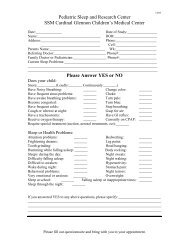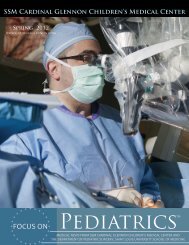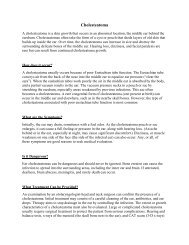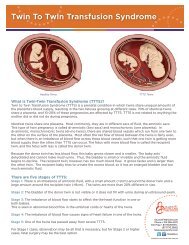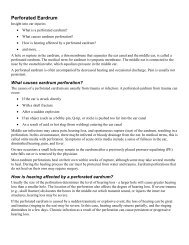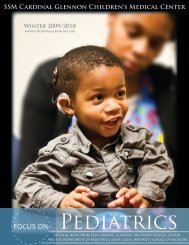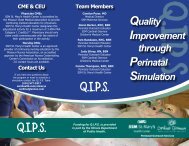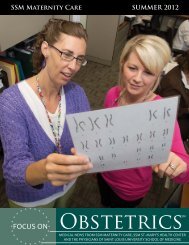pediatric-ALS-AHA-guidelines-circulation_11-2010 - SSM Cardinal ...
pediatric-ALS-AHA-guidelines-circulation_11-2010 - SSM Cardinal ...
pediatric-ALS-AHA-guidelines-circulation_11-2010 - SSM Cardinal ...
Create successful ePaper yourself
Turn your PDF publications into a flip-book with our unique Google optimized e-Paper software.
Kleinman et al Part 14: Pediatric Advanced Life Support S881with a pause for ventilation). Newborns who require CPR inother settings (eg, prehospital, ED, <strong>pediatric</strong> intensive careunit [PICU], etc.), should receive CPR according to infant<strong>guidelines</strong>: 2 rescuers provide continuous chest compressionswith asynchronous ventilations if an advanced airway is inplace and a 15:2 ventilation-to-compression ratio if no advancedairway is in place (Class IIb, LOE C). It is reasonableto resuscitate newborns with a primary cardiac etiology ofarrest, regardless of location, according to infant <strong>guidelines</strong>,with emphasis on chest compressions (Class IIa, LOE C). Forfurther information, please refer to Part 13, “Pediatric BasicLife Support,” and Part 15, “Neonatal Resuscitation.”Extracorporeal Life Support (ECLS)Extracorporeal life support (ECLS) is a modified form ofcardiopulmonary bypass used to provide prolonged deliveryof oxygen to tissues. Consider early activation of ECLS for acardiac arrest that occurs in a highly supervised environment,such as an ICU, with the clinical protocols in place and theexpertise and equipment available to initiate it rapidly. ECLSshould be considered only for children in cardiac arrestrefractory to standard resuscitation attempts, with a potentiallyreversible cause of arrest (Class IIa, LOE C). 128–154When ECLS is employed during cardiac arrest, outcome forchildren with underlying cardiac disease is better than theoutcome for children with noncardiac disease. With underlyingcardiac disease, long-term survival when ECLS is initiatedin a critical-care setting has been reported even after 50minutes of standard CPR. 128,129,139,147MonitoringElectrocardiographyMonitor cardiac rhythm as soon as possible so both normaland abnormal cardiac rhythms are identified and followed.Continuous monitoring is helpful in tracking responses totreatment and changes in clinical condition.EchocardiographyThere is insufficient evidence for or against the routine use ofechocardiography in <strong>pediatric</strong> cardiac arrest. When appropriatelytrained personnel are available, echocardiography maybe considered to identify patients with potentially treatablecauses of the arrest, particularly pericardial tamponade andinadequate ventricular filling (Class IIb, LOE C). 155–162 Minimizeinterruption of CPR while performing echocardiography.End-Tidal CO 2 (PETCO 2 )Continuous capnography or capnometry monitoring, if available,may be beneficial during CPR, to help guide therapy,especially the effectiveness of chest compressions (Class IIa,LOE C). Animal and adult studies show a strong correlationbetween PETCO 2 and interventions that increase cardiac outputduring CPR or shock. 53,163–169 If the PETCO 2 is consistently10 to 15 mm Hg, focus efforts on improving chest compressionsand make sure that the victim does not receiveexcessive ventilation. An abrupt and sustained rise in PETCO 2in adults 170,171 and animals <strong>11</strong>0 is observed just prior to clinicalidentification of ROSC, so use of PETCO 2 may spare therescuer from interrupting chest compressions for a pulsecheck. PETCO 2 must be interpreted with caution for 1 to 2minutes after administration of epinephrine or other vasoconstrictivemedications because these medications may decreasethe end-tidal CO 2 level by reducing pulmonary blood flow.Vascular AccessVascular access is essential for administering medicationsand drawing blood samples. Obtaining peripheral venousaccess can be challenging in infants and children during anemergency; intraosseous (IO) access can be quickly establishedwith minimal complications by providers with variedlevels of training. 172–179 Limit the time spent attempting toestablish peripheral venous access in a critically ill or injuredchild. 180Intraosseous (IO) AccessIO access is a rapid, safe, effective, and acceptable route forvascular access in children, 172–179,181 and it is useful as theinitial vascular access in cases of cardiac arrest (Class I,LOE C). All intravenous medications can be administeredintraosseously, including epinephrine, adenosine, fluids,blood products, 182,183 and catecholamines. 184 Onset of actionand drug levels for most drugs are comparable to venousadministration. 185 IO access can be used to obtain bloodsamples for analysis including for type and cross match andblood gases during CPR, 186 but acid-base analysis is inaccurateafter sodium bicarbonate administration via the IOcannula. 187 Use manual pressure or an infusion pump toadminister viscous drugs or rapid fluid boluses; 188,189 followeach medication with a saline flush to promote entry into thecentral <strong>circulation</strong>.Venous AccessPeripheral IV access is acceptable during resuscitation if itcan be placed rapidly, but placement may be difficult in acritically ill child. Although a central venous catheter canprovide more secure long-term access, its placement requirestraining and experience, and the procedure can be timeconsuming.Therefore central venous access is not recommendedas the initial route of vascular access during anemergency. If both central and peripheral accesses are available,administer medications into the central <strong>circulation</strong> sincesome medications (eg, adenosine) are more effective whenadministered closer to the heart, and others (eg, calcium,amiodarone, procainamide, sympathomimetics) may be irritatingwhen infused into a peripheral vein. The length of acentral catheter can contribute to increased resistance, making itmore difficult to push boluses of fluid rapidly through amultilumen central than a peripheral catheter.Endotracheal Drug AdministrationVascular access (IO or IV) is the preferred method for drugdelivery during CPR, but if it is not possible, lipid-solubledrugs, such as lidocaine, epinephrine, atropine, and naloxone(mnemonic “LEAN”) 190,191 can be administered via an endotrachealtube. 192 However, the effects may not be uniformwith tracheal as compared with intravenous administration.One study of children in cardiac arrest 193 demonstratedsimilar ROSC and survival rates regardless of the method ofDownloaded from circ.ahajournals.org by on October 20, <strong>2010</strong>



